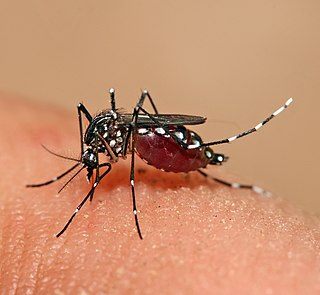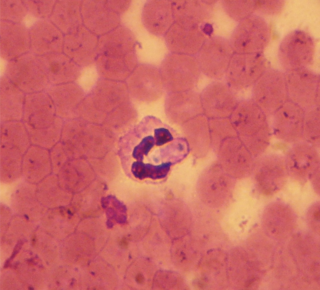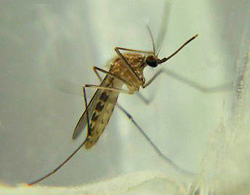Related Research Articles

Mosquitoes are members of a group of almost 3,600 species of small flies within the family Culicidae. The word "mosquito" is Spanish for "little fly". Mosquitoes have a slender segmented body, one pair of wings, one pair of halteres, three pairs of long hair-like legs, and elongated mouthparts.

Aedes albopictus, from the mosquito (Culicidae) family, also known as the (Asian) tiger mosquito or forest mosquito, is a mosquito native to the tropical and subtropical areas of Southeast Asia. In the past few centuries, however, this species has spread to many countries through the transport of goods and international travel. It is characterized by the white bands on its legs and body.

Aedes is a genus of mosquitoes originally found in tropical and subtropical zones, but now found on all continents except perhaps Antarctica. Some species have been spread by human activity: Aedes albopictus, a particularly invasive species, was spread to the New World, including the United States, in the 1980s, by the used-tire trade.

Arbovirus is an informal name for any virus that is transmitted by arthropod vectors. The term arbovirus is a portmanteau word. Tibovirus is sometimes used to more specifically describe viruses transmitted by ticks, a superorder within the arthropods. Arboviruses can affect both animals and plants. In humans, symptoms of arbovirus infection generally occur 3–15 days after exposure to the virus and last three or four days. The most common clinical features of infection are fever, headache, and malaise, but encephalitis and viral hemorrhagic fever may also occur.

Anopheles is a genus of mosquito first described and named by J. W. Meigen in 1818. About 460 species are recognised; while over 100 can transmit human malaria, only 30–40 commonly transmit parasites of the genus Plasmodium, which cause malaria in humans in endemic areas. Anopheles gambiae is one of the best known, because of its predominant role in the transmission of the most dangerous malaria parasite species – Plasmodium falciparum.

Toxorhynchites, also called elephant mosquito or mosquito eater, is a genus of diurnal and often relatively colorful mosquitoes, found worldwide between about 35° north and 35° south. Most species occur in forests. It includes the largest known species of mosquito, at up to 18 mm (0.71 in) in length and 24 mm (0.94 in) in wingspan. It is among the many kinds of mosquito that do not consume blood. The adults subsist on carbohydrate-rich materials, such as honeydew, or saps and juices from damaged plants, refuse, fruit, and nectar.

Sandfly is a colloquial name for any species or genus of flying, biting, blood-sucking dipteran (fly) encountered in sandy areas. In the United States, sandfly may refer to certain horse flies that are also known as "greenheads", or to members of the family Ceratopogonidae. The bites usually result in a small, intensely itchy bump or welt, the strength of which intensifies over a period of 5-7 days before dissipating. Moderate relief is achieved with varying success through the application of over the counter products such as Benadryl (ingested) or an analgesic cream such as After Bite. Outside the United States, sandfly may refer to members of the subfamily Phlebotominae within the Psychodidae. Biting midges (Ceratopogonidae) are sometimes called sandflies or no-see-ums. New Zealand sandflies are in the genus Austrosimulium, a type of black fly.

Hepatozoon is a genus of Apicomplexa alveolates which incorporates over 300 species obligate intraerythrocytic parasites. Species have been described from all groups of tetrapod vertebrates, as well as a wide range of haematophagous arthropods, which serve as both the vectors and definitive hosts of the parasite. By far the most biodiverse and prevalent of all haemogregarines, the genus is distinguished by its unique reciprocal trophic lifecycle which lacks the salivary transmission between hosts commonly associated with other apicomplexans. While particularly prevalent in amphibians and reptiles, the genus is more well known in veterinary circles for causing a tick-borne disease called hepatozoonosis in some mammals.

Culex is a genus of mosquitoes, several species of which serve as vectors of one or more important diseases of birds, humans, and other animals. The diseases they vector include arbovirus infections such as West Nile virus, Japanese encephalitis, or St. Louis encephalitis, but also filariasis and avian malaria. They occur worldwide except for the extreme northern parts of the temperate zone, and are the most common form of mosquito encountered in some major U.S. cities, such as Los Angeles.

The Culicinae are the most extensive subfamily of mosquitoes (Culicidae) and have species in every continent except Antarctica, but are highly concentrated in tropical areas. Mosquitoes are best known as parasites to many vertebrate animals and vectors for disease. They are holometabolous insects, and most species lay their eggs in stagnant water, to benefit their aquatic larval stage.
Dr. Francisco Soca or Soca is a small city in the Canelones Department of southern Uruguay.
Culex vishnui is a mosquito belonging to the Culicidae family. It is the most common vector (carrier) of the Japanese encephalitis virus (JEV) in India, Sri Lanka, Thailand, and Sarawak.

Kimia Alizadeh Zonouzi is an Iranian Taekwondo athlete. Alizadeh won a bronze medal in the taekwondo 57 kg weight class at the 2016 Summer Olympics in Rio de Janeiro by defeating Swedish athlete Nikita Glasnović. This made her the first Iranian woman to win a medal at a Summer Olympics. She also won a gold medal in the women's 63-kg class at the Nanjing 2014 Youth Olympic Games. She beat London 2012 and Rio de Janeiro 2016 gold medallist Jade Jones at the 2015 World Championship to win a bronze medal. She also won a silver medal two years later at the 2017 World Taekwondo Championships.

Under the Shadow is a 2016 Persian-language psychological horror film written and directed by Iranian-born Babak Anvari as his directorial debut. A mother and daughter are haunted by a mysterious evil in 1980s Tehran, during the War of the Cities. The film stars Narges Rashidi, Avin Manshadi, Bobby Naderi, Ray Haratian, and Arash Marandi.

Pokémon the Movie: Volcanion and the Mechanical Marvel, known in Japan as Pokémon the Movie XY&Z: Volcanion and the Exquisite Magearna is a 2016 Japanese animated fantasy adventure film, the 19th in the Pokémon film series produced by OLM, and the third and final film in the XY series. It was directed by Kunihiko Yuyama and written by Atsuhiro Tomioka. The film stars the voices of Rica Matsumoto, Ikue Ōtani, Mayuki Makiguchi, Yūki Kaji, Mariya Ise, Megumi Hayashibara, Shin-ichiro Miki, Inuko Inuyama, Somegoro Ichikawa, Yuka Terasaki, Kōichi Yamadera, Mayu Matsuoka, and Shoko Nakagawa. The film focuses on Councillor Alva of the Azoth Kingdom, who steals the "Soul-Heart" of the artificial Pokémon Magearna to power and control a flying fortress in the kingdom. The Mythical Pokémon Volcanion allies with the Pokémon trainer Ash Ketchum and his friends, Pikachu, Serena, Clemont, and Bonnie to recover Magearna's Soul-Heart.
Snowsnaps is a Canadian CGI–animated television series. It is a preschool-aimed spinoff of the 2015 film Snowtime!, itself an animated remake of the 1984 live-action The Dog Who Stopped the War movie. Produced by Carpediem Film & TV in collaboration with the animation studio Singing Frog and broadcaster Corus Entertainment, the series premiered September 1, 2018 in Canada on Télétoon, La Chaîne Disney and Treehouse TV.

Kimia Hosseini is an Iranian actress.
Kimia or Kimiya is a Persian feminine given name. It may also refer to:
Armigeres is a genus of mosquito belonging to the family Culicidae.
References
- ↑ "Kimia Vu Duc Huong & Harbach, 2007". Mosquito Taxonomic Inventory. Retrieved 13 July 2020.